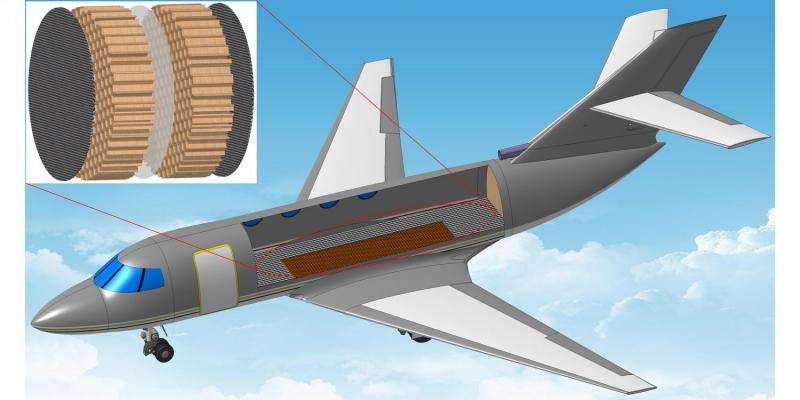Lightweight membrane can significantly reduce in-flight aircraft noise

Riding in a helicopter or airplane can be a noisy experience for passengers. But researchers from North Carolina State University and MIT have developed a membrane that can be incorporated into aircraft to drastically reduce the low-frequency noise that penetrates the cabin.
"This design is promising for making structures that are strong, lightweight, and sound-proof," says Yun Jing, an assistant professor of mechanical and aerospace engineering at NC State and senior author of a paper describing the work.
Aircraft designs incorporate light materials with a honeycomb-like structure into their wings and cabins. It's the material that makes up the floor and ceiling of most airplane cabins. The sandwiched honeycomb structure makes it strong, and the light weight makes the aircraft more fuel efficient.
But these honeycomb structures are very bad at blocking low-frequency noise - like the noise of an aircraft engine. And adding insulation materials to limit the noise would add significant weight to the aircraft, making it much less fuel efficient.
NC State and MIT researchers have developed a possible solution.
They have created a thin, lightweight membrane that covers one side of the honeycomb structure, like the skin of a drum. When soundwaves hit the membrane, they bounce off rather than passing through.
"It's particularly effective against low-frequency noise," Jing says. "At low frequencies - sounds below 500 Hertz - the honeycomb panel with the membrane blocks 100 to 1,000 times more sound energy than the panel without a membrane."
The membrane is made of rubber that is about 0.25 millimeters thick, and adds approximately 6 percent to the overall weight of the honeycomb panel.
"The membrane is relatively inexpensive to produce, and can be made of any material that does not impact the structural integrity of the honeycomb panel," says Ni Sui, a Ph.D. student in Jing's lab and lead author of the paper. "It could make flying much more pleasant for passengers -particularly in helicopters."
The paper, "A Lightweight yet Sound-proof Honeycomb Acoustic Metamaterial," is published online in Applied Physics Letters.
More information: Applied Physics Letters, scitation.aip.org/content/aip/ … 17/10.1063/1.4919235
Journal information: Applied Physics Letters
Provided by North Carolina State University



















